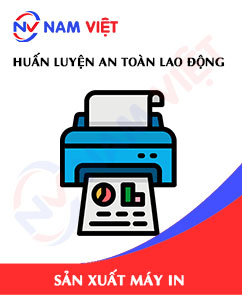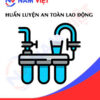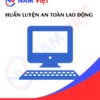Occupational Safety Training in Printer Manufacturing
99,000 ₫
Note: The above price is calculated per person, and the price may fluctuate depending on the number of trainees participating in the course and the market movements. For more accurate price support, please refer to the price list or contact our consulting staff directly.
Occupational safety is an important issue in factories manufacturing printers and needs to be addressed promptly to ensure the health and safety of workers and enhance the reputation of businesses. The Occupational Safety Training course is one of the effective solutions to raise awareness about preventing workplace accidents for workers participating in printer manufacturing.
Table of Contents
Toggle1. Overview of Printers
a. What is a printer?
A printer is a computer peripheral device used to produce paper copies from electronic files. It allows users to print documents, images, graphics, and various types of information on paper or other materials such as decals, fabric, labels, etc.
Printers operate by printing individual characters or images onto a sheet of paper using ink or toner, through print heads controlled by the computer. Common types of printers today include laser printers, inkjet printers, and thermal printers.
Printers are commonly used in offices, shops, schools, and homes where printing documents, forms, reports, invoices, and other materials is necessary.

b. Machinery for printer manufacturing
The production and assembly of a complete printer involve multiple steps and use various types of machinery and equipment. Key machines and equipment include:
- Metal cutting machines: Used to cut metal components of the printer such as the frame, print rollers, paper feed rollers, and other parts.
- Die stamping machines: Used to mold plastic components like ink cartridges, print heads, and other printer parts.
- CNC lathes: Used to machine metal parts of the printer according to pre-programmed designs.
- Surface finishing machines: Used to treat metal surfaces of printer parts to create smooth and aesthetically pleasing finishes.
- Plastic injection machines: Used to mold plastics into the required shapes for components such as ink cartridges, print heads, and other parts.
- Packaging machines: Used to package printer parts and components at different stages of production.
- Assembly machines: Used to assemble printer components into complete products.
- Quality inspection equipment: Used to test the quality and functionality of printers before shipping.

c. Printer manufacturers in Vietnam
Famous global printer brands include:
- HP (Hewlett-Packard): One of the largest and most well-known printer brands worldwide.
- Canon: A leading brand known for high-quality and widely used printers.
- Epson: Offers a range of multifunction and professional printers with high resolution.
- Brother: A well-known brand for printers, fax machines, and scanners.
- Xerox: One of the largest global brands specializing in professional printing products.
- Samsung: A popular global brand providing multifunction and laser printers.
- Lexmark: Produces professional printing products with advanced features, including laser and inkjet printers.

d. Specific jobs in a printer manufacturing factory
Group 1
- CEO, deputy CEO, and department heads in the printer manufacturing factory.
Group 2
- Safety officers: manage safety in the factory, design safety procedures, supervise, and enforce employees’ compliance with safe working processes.
Group 3
- Metal manufacturing: This department produces metal parts for printers such as frames, print rollers, paper feed rollers, and other components.
- Plastic manufacturing: This department produces plastic components for printers like ink cartridges, print heads, and other parts.
- Metal processing: This department machines metal parts according to technical drawings.
- Assembly: Components are assembled into complete products.
- Quality control: Finished products are inspected to ensure proper operation and meet technical requirements.
- Packing and shipping: Products are packaged and transported to stores or distributors.
Group 4
- Office, service, sales, and marketing tasks.
- Production management, quality management, human resources management, materials management, finance and accounting management.
- Design: The design team creates technical designs and drawings for new products.

e. Common types of printers on the market
Currently, there are many types of printers available to meet users’ needs. Common types include:
- Laser printers: Use laser printing technology for fast, high-quality printing, typically used in offices and professional settings.
- Color inkjet printers: Use inkjet technology to print on paper, commonly used for images and office documents.
- Multifunction printers: Combine printing, copying, scanning, and faxing functions, commonly used in offices.
- Thermal printers: Use heat to print directly onto paper, often used for photo printing and label printing.
- Dot matrix printers: Use pins to print on paper, commonly for invoices, receipts, and vouchers.
- Large format printers: Capable of printing on larger sheets, often used in advertising and signage industries.
- 3D printers: Can create three-dimensional products from computer-designed models, often used in industry, architecture, and product design.
2. Overview of occupational safety training for printer manufacturing
In this article, we focus on issues related to Group 3, because Group 3 directly participates in the production process and faces the highest occupational safety risks. For other groups, refer here.
a. What is Group 3 occupational safety training?
- Group 3 occupational safety training consists of sessions that raise workers’ awareness of accident prevention at work.
- This training course helps workers identify and avoid hazards, reducing the risk of accidents during work.
REGISTER FOR OCCUPATIONAL SAFETY TRAINING SERVICE
b. Training duration
Initial occupational safety training
- Total training time is at least 24 hours, including testing time.
- 8 hours of theory on safety policies, laws, and occupational hygiene
- 8 hours of theory on basic knowledge of occupational safety and hygiene
- 4 hours of theory on specialized training content
- 2 hours of practical training on specialized content
- 2 hours of theoretical examination at the end of the course
The safety training center will divide the time into multiple sessions depending on workers’ schedules. Typically, there are 6 sessions, with the course lasting 3 days, provided the manufacturing company can arrange continuous study time.
Periodic occupational safety training
- Before the occupational safety card expires, workers who wish to renew it must undergo periodic occupational safety training, with training time being at least 50% of the initial training duration.
Explanation: The total periodic occupational safety training time is at least 12 hours, including testing. After completing the periodic course and passing the exam, workers will have their occupational safety card renewed.
c. Training content
| No. | TRAINING CONTENT | TRAINING DURATION (HOURS) | |||
| Total | Including | ||||
| Theory | Practical | Exam | |||
| I | System of safety policies, laws, and occupational hygiene | 8 | 8 | 0 | 0 |
| 1 | Overview of legal documents on occupational safety and hygiene. | 6 | 6 | ||
| 2 | System of safety and hygiene standards and technical regulations. | 1 | 1 | ||
| 3 | Specific regulations from state management agencies on safety and hygiene when building, expanding, or renovating facilities, as well as using, storing, and inspecting machines, equipment, materials, and substances with strict safety requirements. | 1 | 1 | ||
| II | Basic knowledge of occupational safety and hygiene | 8 | 8 | 0 | 0 |
| 1 | Basic knowledge of hazards and harmful factors at the workplace. | 4 | 4 | ||
| 2 | Methods to improve working conditions. | 1 | 1 | ||
| 3 | Safety culture in production and business. | 1 | 1 | ||
| 4 | Rights and obligations of employers and employees; policies on occupational safety and hygiene; functions and responsibilities of the safety network. | 1 | 1 | ||
| 5 | Safety rules, signs, instructions, use of safety equipment, personal protective equipment; first aid skills and occupational disease prevention. | 1 | 1 | ||
| III | Specialized training content | 6 | 4 | 2 | 0 |
| Comprehensive knowledge of machines, equipment, substances causing hazards; risk analysis, evaluation, management; safe work procedures for machines, equipment, and substances with strict safety requirements. | 6 | 4 | 2 | ||
| IV | Final safety training exam | 2 | 2 | 0 | 0 |
| Total | 24 | 22 | 2 | ||
See also training content of 6 groups
d. Occupational safety card
After completing the occupational safety training and passing the exam, workers will be issued an occupational safety card (commonly referred to as Group 3 occupational safety certificate).
The Group 3 card displays information such as name, date of birth, job, and specific working environment. It also shows training duration, red stamp, and signature confirming course completion.
According to the regulations specified in Clause 2 of Article 24 of Decree 44/2016/ND-CP, there are two cases:
- If the employer and employee have a labor contract, the employer must sign, stamp, and seal the safety card for the trained Group 3 employee after completing the training course and passing the exam.
- If the worker is freelance or temporary, without a labor contract, the training unit must sign, stamp, and seal the safety card after completing the training course and passing the exam.

3. Identifying Hazards Affecting Workers During Printer Manufacturing
During the process of printer manufacturing, workers may encounter several hazards affecting health and occupational safety, including:
- Occupational accident risks: Such as getting hands caught in printer parts, slipping while moving printers, or burns when working with hot printer components.
- Dust exposure risks: During production, printer components often require grinding, cutting, or polishing, generating dust. Workers may be exposed to metal dust, wood dust, or ink dust, which can affect the respiratory system and cause other health issues.
- Noise exposure risks: Printers often generate loud noise, especially during printing. Continuous exposure to noise can cause hearing problems, stress, and fatigue for workers.
- Laser exposure risks: For laser printers, the laser used in printing can affect workers’ eyes and skin if they are not properly protected.
- Electrical hazards: If electrical equipment in the factory is not regularly maintained or properly insulated and waterproofed, it can pose the risk of electric shock to workers during production.

4. Common Occupational Accidents for Workers in Printer Manufacturing
Some common occupational accidents for workers in printer manufacturing include:
- Cut and burn accidents: Workers may suffer burns when contacting hot printer parts or cuts when handling sharp components.
- Fall and slip accidents: Workers may fall or slip while moving printers or working on slippery floors.
- Puncture accidents: During printer operation, accidents from sharp printer parts may occur.
- Dust-related accidents: During production, printer components often require grinding, cutting, or polishing, generating dust. Workers may be exposed to metal dust, wood dust, or ink dust, affecting the respiratory system and causing other health issues.
- Noise-related accidents: Printers often generate loud noise, especially during printing. Continuous exposure can lead to hearing problems, stress, and fatigue.
- Laser-related accidents: For laser printers, the laser can affect workers’ eyes and skin if not properly protected.

5. Safety Measures in Printer Manufacturing
Implementing safety measures during printer manufacturing is crucial to ensure worker safety and minimize occupational accident risks. Some safety measures include:
- Use of personal protective equipment: Workers must be equipped with helmets, safety glasses, gloves, safety shoes, protective clothing, masks, and noise-canceling headphones.
- Maintain cleanliness and ventilation: Printer manufacturing facilities should be clean, well-ventilated, and provide proper airflow to reduce risks of headaches, dizziness, shortness of breath, and other health problems due to environmental pollution.
- Occupational safety training: Workers should be trained in production procedures, safety skills, and proper use of protective equipment.
- Machine inspection and maintenance: Ensure machines are functioning properly and carry out regular maintenance and repairs to prevent accidents caused by equipment failure.
- Electrical safety checks: Inspect electrical equipment, circuits, wiring, outlets, and power sources to ensure worker safety.
- Use of safe materials: Utilize safe and high-quality materials during production to minimize risks of fire, explosion, or other material-related accidents.
- Monitoring and supervision: Implement monitoring to ensure compliance with safety regulations and prevent unexpected occupational accidents.
- Regular work environment monitoring in factories, collecting and analyzing harmful factors to adjust and reduce hazards, thereby preventing occupational diseases.
6. Benefits of Occupational Safety Training in Printer Manufacturing
An Toan Nam Viet provides businesses with the following benefits upon completing occupational safety training courses as regulated by Decree 44/2016/ND-CP regarding occupational safety and hygiene:
- Workers can identify potential occupational hazards and take preventive measures to avoid accidents.
- Businesses can establish risk prevention measures in production, operation, and maintenance processes.
- Minimize costs associated with safety incidents.
- Continuous production enhances labor productivity and product quality.
- Compliance with occupational safety laws reduces legal risks.
- Enhances corporate reputation and professionalism, thereby boosting the company’s brand.
Nam Viet’s training courses serve as a solution to protect individuals from external hazards, preventing injuries or even fatalities.
REGISTER FOR OCCUPATIONAL SAFETY TRAINING SERVICE
7. Customer Feedback After Completing Occupational Safety Training in Printer Manufacturing
An Toan Nam Viet has many years of experience supporting businesses across Vietnam, particularly in the southern provinces. This responsibility is extremely valuable to Nam Viet, and the company continually improves its Occupational Safety Training professionalism. The motivation for Nam Viet’s growth comes from positive feedback and suggestions from partner businesses. Below are some of the feedback from our clients.
Bac Nam E&C Investment Construction Joint Stock Company
“The first time using An Toan Nam Viet’s services, I was surprised by the 24/7 support from the consulting team. Class organization was fast and convenient for our company. Thank you very much for Nam Viet’s service!”
See more customer interviews after using the service from An Toan Nam Viet
8. An Toan Nam Viet Occupational Safety Training Capability
An Toan Nam Viet is a reputable and high-quality occupational safety training center in Vietnam, conducting continuous training sessions at production workshops, factories, or construction sites nationwide (all 63 provinces).
REGISTER FOR OCCUPATIONAL SAFETY TRAINING SERVICE
Occupational Safety Training License
- An Toan Nam Viet has been inspected and certified by the Department of Labor Safety under the Ministry of Labor – Invalids and Social Affairs, certifying the eligibility to conduct occupational safety and hygiene training, further strengthening our occupational safety training capabilities.

Training Materials and Lectures
- Before being used in OST courses, all training materials are reviewed to ensure knowledge accuracy and effectiveness.
- Instructor teaching methods are standardized according to An Toan Nam Viet standards, developed by experts in occupational safety and hygiene training to maximize knowledge retention for learners.
Facilities
- Controlling classroom factors improves teaching efficiency and knowledge absorption.
- Our training facilities provide spacious classrooms meeting standards for area, lighting, and training equipment.
9. Nationwide Reputable Occupational Safety Training Center
At An Toan Nam Viet, we prioritize the profession of occupational safety training. Teaching workers to protect themselves equips them with safety knowledge for their livelihoods and contributes to national development.
To ensure training effectiveness, we carefully prepare every detail—from tools and teaching equipment to curriculum, materials, sound, and lighting.
Our occupational safety instructors are experienced professionals, some with research on hazard identification across various industries and preventive measures.
Lectures are based on practical experience, delivered vividly and clearly, ensuring workers comfortably absorb knowledge. Training always adheres to Decree 44/2016/ND-CP.
Learners acquire hazard prevention measures and self-protection techniques, applicable in real work situations.
Our training center proudly offers professional and reputable occupational safety training with advantages:
- Competitive training costs while maintaining quality.
- Flexible training schedules accommodating production needs.
- Fast certification procedures compliant with the law.
- Experienced instructors.
- Controlled classroom factors enhancing teaching efficiency and knowledge absorption.
- Lectures tailored to occupational safety in enterprises.
- Dedicated and professional support for customers promptly and accurately.

10. Additional Reference Materials for Occupational Safety Training in Printer Manufacturing
- Occupational Safety Training Materials Set
- Printer Manufacturing Occupational Safety Materials
- Occupational Safety Training Test Set
- Printer Manufacturing Occupational Safety Training Curriculum
- Printer Manufacturing Occupational Safety Quiz
1 review for Occupational Safety Training in Printer Manufacturing
No comments yet















namchinh.haiphong341
Đơn vị an toàn lao động uy tín tại Việt Nam nhé!